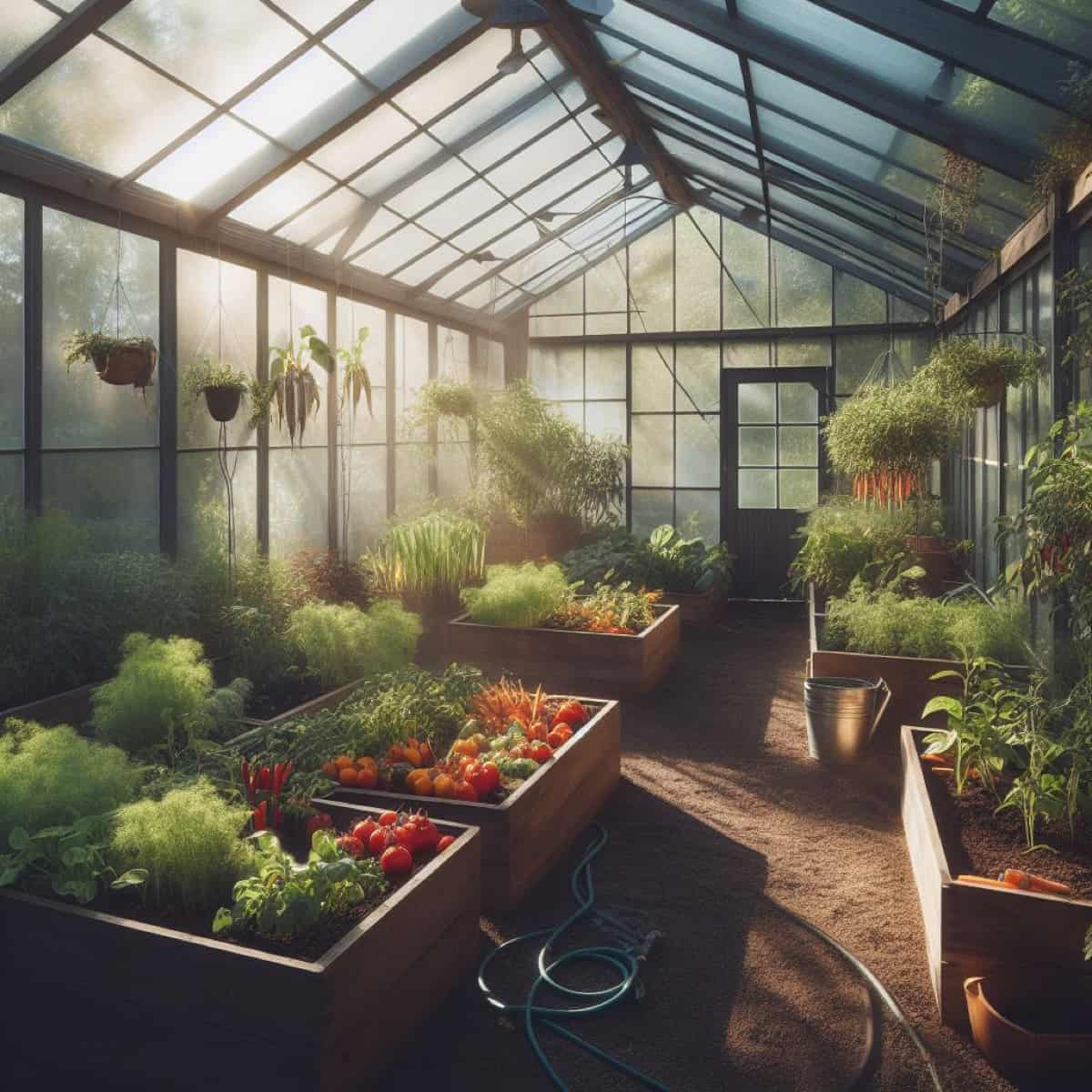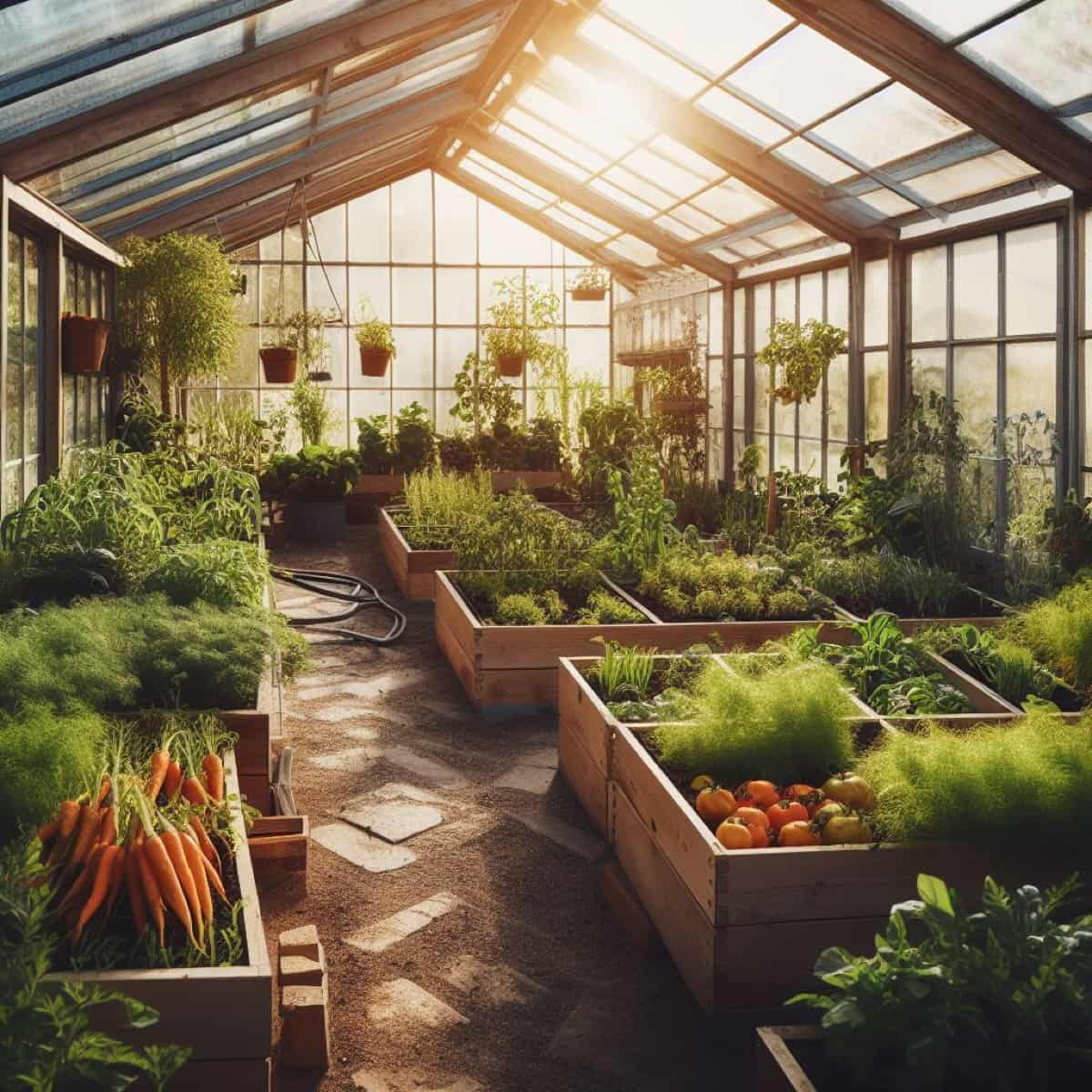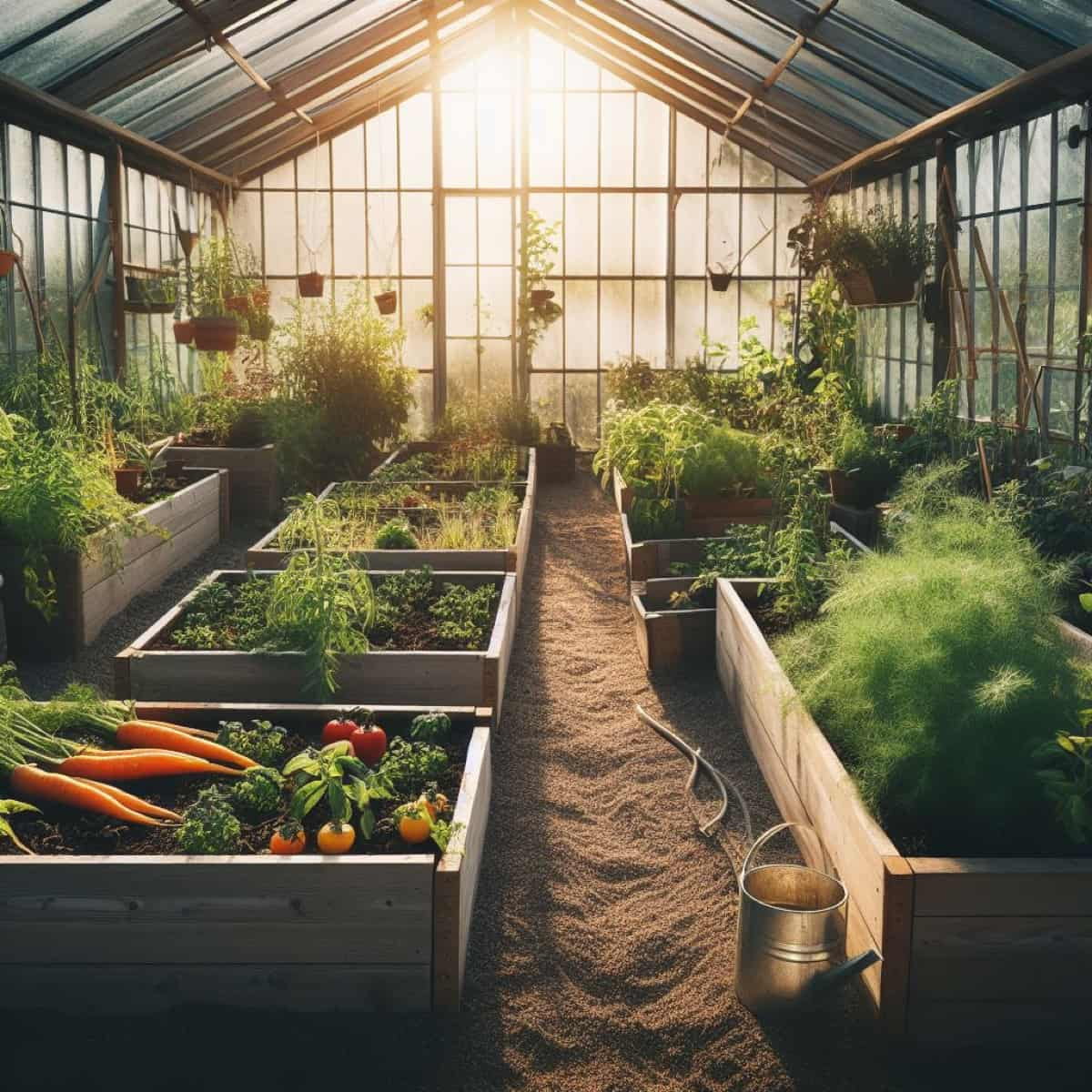Greenhouse-raised bed gardening is a sustainable and efficient method of cultivating plants in a controlled environment. Raised bed greenhouse gardens involve using elevated plant beds within a greenhouse, where temperature, humidity, and light levels can be regulated. Using raised beds optimizes space, improves drainage, and enhances soil quality. The controlled environment fosters healthier, more abundant crops. It is popular for amateur and professional gardeners seeking to extend their growing seasons and promote eco-friendly, organic cultivation practices.

How to Construct Raised Garden Beds in a Greenhouse
Choosing the Right Location for Your Greenhouse Raised Beds
The ideal location to build raised garden beds in a greenhouse is crucial for successful gardening. Choose a spot with ample sunlight, preferably facing south, to maximize exposure. Ensure it’s level, well-drained, and free from strong winds that could damage the greenhouse structure. Access to water and electricity is essential for irrigation and climate control systems. Consider proximity to your home for convenience.
Also, factor in local building codes and zoning regulations. Finally, think about the microclimate of your region, as this can influence the temperature and humidity inside the greenhouse. A well-thought-out location will contribute to the productivity and longevity of your garden.
Selecting the Ideal Size and Shape to Create Raised Beds in the Greenhouse
Choosing the right size and shape for your raised garden beds is essential for efficient gardening. The ideal dimensions depend on your space and preferences. There are so many greenhouse raised bed ideas available on the internet. Rectangular or square beds are common, as they’re easy to work with, but consider your reach to avoid overstretching.
A typical width is 3-4 feet, allowing you to reach the center comfortably. Length varies but should suit your garden’s size. Bed height is typically 12-36 inches, catering to your comfort and soil depth requirements. Smaller beds suit specific crops, while larger ones offer versatility. Select dimensions that fit your space needs and make gardening more manageable.
Materials and Tools Needed for Building Greenhouse Raised Beds
You’ll need various materials and tools to build raised garden beds in a greenhouse. Materials include lumber for bed frames (cedar or treated wood for longevity), screws, or bolts for assembly. For the best way to build a raised garden bed, you’ll also need a level, measuring tape, and a saw for cutting the wood to your desired dimensions. For the greenhouse cover, consider UV-resistant polyethylene or polycarbonate panels.
In case you missed it: How to Build an Apartment Balcony Raised Garden Bed: DIY for Vegetables, Flowers and Herbs

Fastening hardware like clips or staples secures the cover. Acquire compost, peat moss, and garden soil to enhance soil quality. Hand tools like shovels, rakes, and gloves are crucial for bed preparation. An irrigation system, such as drip hoses and a thermometer for the greenhouse, complete the list for a successful project.
Step-by-Step Guide to Constructing Raised Garden Beds in a Greenhouse
- Plan Bed Dimensions: For a DIY raised bed greenhouse, first decide the size and shape of raised beds, considering accessibility and space.
- Gather Materials and Tools: Acquire lumber, screws, a saw, a level, measuring tape, and a greenhouse cover material. For soil, gather compost, peat moss, and garden soil.
- Frame Assembly: Cut the lumber to your chosen dimensions, then assemble the bed frames using screws or bolts. Ensure they are level and square.
- Assemble the Frame: Construct a rectangular frame by screwing the boards together at the corners.
Preparing the Soil for Your Greenhouse Raised Beds
To prepare the soil to build raised garden beds in a greenhouse. First, remove any existing vegetation or debris from the bed area. Next, loosen the native soil below the raised bed structure by digging or tilling. Mix in organic matter like compost and peat moss to enhance soil fertility, moisture retention, and drainage. Ensure a balanced pH by testing the soil and making necessary adjustments.
Fill the raised beds with the amended soil mixture, maintaining a level and uniform surface. Finally, water the soil to ensure it’s adequately moist before planting. Properly prepared soil provides a healthy foundation for greenhouse-raised crops, promoting optimal growth.
Planting and Sowing Seeds in Greenhouse Raised Beds
Planting and sowing seeds in greenhouse-raised beds is a straightforward process. First, prepare the soil by amending it with compost and ensuring it’s moist. Create furrows or holes in the soil to the recommended depth for your seeds. Place seeds or seedlings in the furrows, following spacing and depth guidelines on seed packets.
Cover the seeds with soil, gently patting them down. Water thoroughly but gently to avoid disturbing the seeds. Maintain the appropriate temperature, light, and humidity conditions inside the greenhouse for optimal germination and growth. Regularly monitor and water your plants, and adjust environmental controls for a thriving greenhouse garden.
Watering and Irrigation Techniques for Greenhouse Raised Beds
Proper watering and irrigation in greenhouse-raised beds are crucial for plant health. Consider drip irrigation, soaker hoses, or a watering can with a fine rose attachment for precise and controlled watering. Water early in the day to prevent fungal issues, ensuring the soil is consistently moist, not waterlogged. Monitor soil moisture levels with a soil moisture meter or your fingers.
In case you missed it: How to Build a Raised Garden Bed for Under $100 in 9 Easy Steps: Low-cost and Cheap Ideas

Adjust the watering frequency based on plant needs and greenhouse conditions, like temperature and humidity. Using a water-soluble fertilizer in your irrigation routine can provide necessary nutrients. Tailor your approach to your specific crops and their requirements to build raised garden beds in a greenhouse.
Managing Temperature and Humidity in a Greenhouse with Raised Beds
- Ventilation: Install vents and fans to regulate temperature and humidity. Automated systems can help, opening vents and turning on fans when conditions require it.
- Shade Cloth: Use shade cloth to reduce excessive heat and direct sunlight, mostly in the summer.
- Heating Systems: Install heaters for colder months to prevent frost damage and maintain a consistent temperature.
- Misting Systems: Employ misting systems to increase humidity when necessary, especially in dry climates.
- Thermometers and Hygrometers: Regularly monitor conditions with these instruments to make informed adjustments.
- Proper Plant Spacing: Adequate spacing between plants helps prevent humidity build-up and disease spread.
- Disease Management: Promptly address any signs of fungal diseases that thrive in high humidity.
Maintaining and Caring for Your Raised Beds In The Greenhouse
- Regular Monitoring: Check for pests, diseases, and signs of stress in your plants daily.
- Watering: Maintain consistent soil moisture. Avoid overwatering, as it causes root rot and fungal issues.
- Fertilization: Use organic or balanced fertilizers to provide essential nutrients to your plants.
- Weeding: Keep the beds free of weeds that can compete for resources and harbor pests.
- Pruning: Regularly trim and train your plants to optimize space and airflow.
- Cleaning: Keep the greenhouse tidy by removing debris and dead plant matter.
- Environmental Control: Adjust temperature, humidity, and ventilation as needed.
Troubleshooting Common Issues in Greenhouse Raised Bed Gardening
- Pest Infestations: Employ natural predators or organic pest control methods to combat common garden pests.
- Disease Outbreaks: Monitor plant health, practice crop rotation, and ensure proper spacing to reduce the risk of diseases.
- Overwatering or Underwatering: Use a moisture meter to maintain consistent soil moisture; avoid waterlogged or dry conditions.
- Temperature Fluctuations: Invest in heating and cooling systems for climate control, preventing damage from extreme temperatures.
- Nutrient Deficiencies: Regularly fertilize with a balanced fertilizer and maintain soil health through organic matter addition.
- Poor Drainage: Improve drainage by amending soil with organic materials and ensuring raised beds have adequate drainage.
In case you missed it: How to Build a Raised Garden Bed With Recycled Materials in 7 Easy Steps

Conclusion
Building raised garden beds in a greenhouse offers an exciting opportunity for year-round gardening. In these ten simple steps, you’ve learned to build raised garden beds in a greenhouse, including choosing the right location, assembling your beds, and creating the ideal soil environment. With these techniques, your greenhouse-raised beds will flourish, providing a productive and satisfying gardening experience throughout the seasons. Happy gardening!
- Feed Your Flock for Less: Top 10 Tips to Save on Chicken Feed
- Ultimate Guide to Ossabaw Island Hog: Breeding, Raising, Diet, and Care
- Hatching Answers: The Top 10 Reasons Your Chickens Aren’t Laying Eggs
- Eggs and Economics: Breaking Down the Cost of Raising Backyard Chickens
- Defend Your Greens: Proven Methods to Keep Iguanas Out of Your Garden
- Ultimate Guide to Cinnamon Queen Chicken: A Comprehensive Guide for Beginners
- Ultimate Guide to California Tan Chicken: Breeding, Raising, Diet, Egg-Production and Care
- Ultimate Guide to Marsh Daisy Chicken: Breeding, Raising, Diet, and Care
- 10 Types of Chicken Farming Businesses You Can Start for Profits